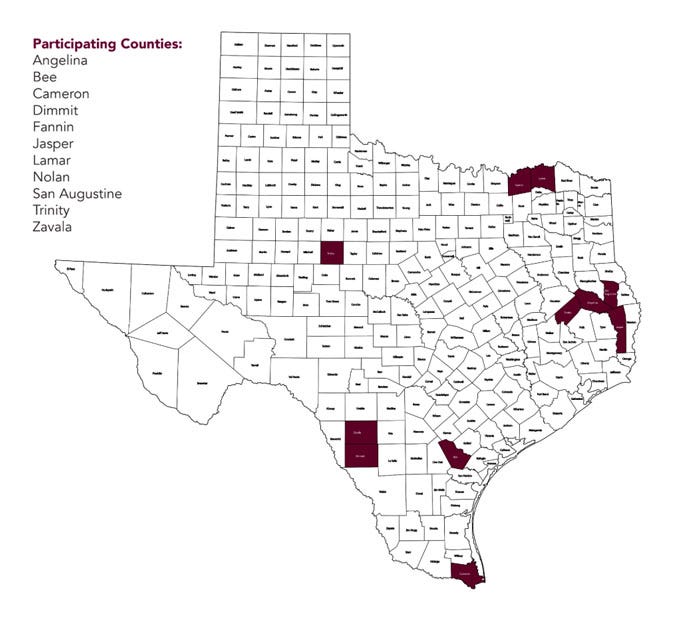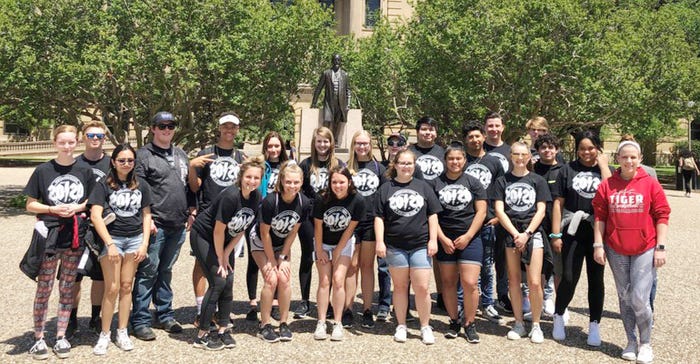November 5, 2021
In Texas, rural students graduate high school at a higher rate than the state average but are less likely than their urban peers to enroll in college.
To help address this issue, the Texas A&M AgriLife Extension Service has created the Rural Student Success Initiative, RSSI, to help increase the number and success of rural students seeking post-secondary education.
“Geography, limited social capital and a general lack of structured support are among the reasons rural students are less likely to attempt and complete a postsecondary education than their urban counterparts,” said RSSI project director Maria Luna-Torres, Ph.D., Bryan-College Station.
Currently, about 41% of urban adults in the U.S. have a college degree, while only 28% of rural adults have one. Furthermore, the close to 900,000 rural students in numerous small- and medium-sized school districts spread remotely all over Texas present a logistical challenge to delivering a consistent college access and success framework.
The Rural Student Success Initiative
The RSSI was established by AgriLife Extension in 2018 with an initial $3.88 million in grants from the Greater Texas Foundation, the T.L.L. Temple Foundation, Meadows Foundation and Trellis Foundation. The initiative currently supports 21 rural school districts in 19 Texas counties.
“It was important to develop an initiative that could reach rural students in the communities where they live and provide them with the resources they need to make informed decisions about pursuing a postsecondary certificate or degree program,” said George Grainger, assistant vice president at the Texas A&M Foundation, Bryan-College Station.
The Texas A&M Foundation played an early role in developing the initiative and securing initial funding for the RSSI, which currently serves about 6,000 students in grades 8-12.
About half of the school districts in Texas can be considered rural, and around one-third have 60 or fewer students in each of their freshman through senior classes.
“School staff in rural ISDs typically serve multiple roles, and many of them lack the resources or have the time needed to help students and their parents navigate the complicated college-going process,” Grainger said. “This process includes preparing compelling college applications to understanding the byzantine array of financial aid opportunities.”
He said in developing the RSSI, the focus was on those isolated rural communities and school districts that lacked the support infrastructure to help students realize the potential for and advantages of a higher education.

Luna-Torres added that most of the districts the RSSI serves are also in under-resourced areas of the state, and most of the counties have poverty rates higher than — and in some cases double — state and national poverty rates.
“Many of the school districts we support are in some of the state’s poorest communities, with both a high percentage of economically disadvantaged students and a low college matriculation rate,” she said.
She noted the mission of the initiative also aligns well with the AgriLife Extension mission of improving the overall quality of life for all Texans.
“Getting a good postsecondary education is possibly the most positive life-altering thing a person can do when it is done with intention,” Luna-Torres said. “Some of the benefits of higher education extend beyond monetary rewards. Students can have a more rewarding career, greater civic engagement and the ability to live a happier, healthier life.”
How the initiative is implemented
The RSSI is implemented by Luna-Torres and a central staff of college access specialists and “leadership coaches” working in collaboration with the agency’s statewide network of AgriLife Extension county agents.
“In developing the RSSI, we realized AgriLife Extension already had a strong presence in rural communities and knew those agents would be indispensable in helping bring the program to these communities and their local school district,” Grainger said.
Luna-Torres describes the AgriLife Extension agents as the initiative’s critical “entry point” into rural communities.
“They help us understand the community’s needs and to identify and get access to the people we need to connect with,” she said. “They also help us work with the ISD to develop a strategic plan for student success, which includes several ‘milestones’ the students are expected to achieve.”
One of those involved in the initiative since its inception has been Bethany Arie, an AgriLife Extension agent in Fannin County, who has worked with the RSSI since the 2018/2019 school year. �
“Our involvement in the RSSI really became a priority in this county because it addresses one of the emerging needs our agency identified in collaboration with the community — the need for a better educated local workforce,” Arie said.
Through the initiative, Arie works with the Trenton Independent School District and Trenton High School, which has a total student body of about 240. She acts as a liaison between AgriLife Extension, the initiative and the school. In that role, she helps the school develop a strong work plan to secure initiative funding, collaborates with the school principal and counselor to help students access colleges and universities, and provides applicable agency educational programming to students. She also helps facilitate college tours and promotes other activities to engage parents more directly in their child’s higher education.
“Although the pandemic has made it difficult to implement many of our activities, overall, we have seen an increase in college applicants and college acceptances among the students,” Arie said. “And whether they choose to return to this community to apply that education or not, we know we have helped set them on a path that will afford them greater opportunities in life.”
RSSI support strategies
Luna-Torres said the RSSI engages four key constituencies to influence student academic goal-setting and success: students; parents/adult caregivers; rural schools, including leaders and instructional and counseling staff; and AgriLife Extension agents. It focuses its support strategies on distinct sections of the higher education access and completion pipeline to support rural students and their parents.
“We apply an evidenced-based framework for student success and develop intention-driven strategies that are culturally relevant to the school’s community,” Luna-Torres said.
A local leadership team of secondary and postsecondary leaders, counselors, parents, and community leaders, co-led by the RSSI team and inclusive of the county agent and school district, drives the co-development and implementation of strategies at the local level. The local team informs and guides the implementation of the strategic work plan to support students in grades eight through 12 and involve their parents.
Once in college, the RSSI continues to support these rural students with customized virtual advising services specifically designed to supplement and reinforce postsecondary retention and completion efforts.
“The AgriLife Extension network collaborates with best-in-class, credible college access organizations, and initiatives to provide students, their parents, and schools with information and services that have been shown to help students achieve success in postsecondary education,” Luna-Torres said. “Also, through partnership building, we are looking to connect school districts, higher education partners and the workforce sector to ensure students are completing credentials that they can actually use in the labor market.”
She said some of the organizations and initiatives with which the RSSI collaborates include the Texas Higher Education Coordinating Board, Educate Texas, Collegiate Edu-nation, Texas OnCourse, and the Texas Rural Leadership Program – another AgriLife Extension effort to enhance rural communities.
“Without the generous funding from a cadre of foundations, the collaboration of these education-oriented organizations, and the people in the communities and school districts we work with, the RSSI would not have been able to help these thousands of rural students in multiple Texas counties,” Luna-Torres said.
Getting a firsthand look
“One of the most important aspects of the RSSI strategy is to give rural students the opportunity to actually visit an area college or university,” Luna-Torres said. “This makes it possible for the student to actually envision going to that college or university and being part of the higher education experience.”
She said the initiative tries to involve students from as early as the eighth grade in these tours to help them visualize and internalize the possibility of attending college.
Some of the colleges and universities rural students have visited in conjunction with RSSI include Stephen F. Austin State University, Texas A&M University, Texas A&M–Texarkana, Texas A&M-Kingsville, Texas Tech University, Angelina College, The University of Texas, University of Texas-San Antonio, University of Texas-Permian Basin, Lamar Institute of Technology and Texas State Technical College.
 Juniors and seniors from Trenton High School visited Texas A&M University in Bryan-College Station to get an up-close look at campus life. (Texas A&M AgriLife photo)
Juniors and seniors from Trenton High School visited Texas A&M University in Bryan-College Station to get an up-close look at campus life. (Texas A&M AgriLife photo)
“Although Texas A&M is deeply committed to the RSSI, it is not focused only on bringing students into the Texas A&M University System. We have the broader goal of expanding rural student access and success, regardless of what higher education institution they choose to attend,” she said.
She said the main thrust of the initiative is just to help provide the information and experiences needed for students and their parents to make informed decisions about selecting a postsecondary certificate or degree program that best matches the student’s interests and personal aspirations.
The initiative going forward
“Our experiences from the initial years of RSSI implementation have demonstrated rural communities lack access to credible, unbiased information about college,” Luna-Torres said. “But we have also learned that AgriLife Extension is in a unique position to help alleviate this lack of knowledge.”
She said adjustments to the initiative have been made based on lessons learned from its initial implementation.
“We have moved to breaking the initiative’s implementation into phases versus delivering the treatment and interventions all at once,” Luna-Torres said. “Also, we now deliver information and training in smaller chunks so as not to overwhelm the school district where we are working. This refined implementation approach is playing out beautifully.”
Initiative intervention is provided in three phases: data infrastructure setup, strategy development and activities design, and plan execution and coaching.
“We dedicate time for the school to just tell us in their own words why they think their students are not going to college,” she said. “It’s critically important to listen to them as they know their school district best.
“Our intent is to operate in a spirit of true collaboration and help elevate the district to the next level. We don’t claim to have instant solutions as this is hard work that takes time and a sincere effort to help some of our most vulnerable students and families.”
The RSSI has also engaged the support of the Texas Higher Education Coordinating Board’s Virtual Advising Platform, which provides virtual retention support. The platform is scalable to rural school districts, and the coordinating board is piloting with the initiative to reach students early in their junior year while in high school and follow them through college with messaging.
“We now have some preliminary data and success indicators on the positive impact of the RSSI on rural schools and students, and we will continue to gather more data on the initiative’s impact to seek additional funding,” Luna-Torres said. “Contingent on this additional funding, we have the potential to serve hundreds more rural school districts and encourage thousands more rural students to seek a postsecondary education. We hope we will be able to scale up and expand the RSSI to support even more rural communities.”
Source: is AgriLife TODAY, which is solely responsible for the information provided and is wholly owned by the source. Informa Business Media and all its subsidiaries are not responsible for any of the content contained in this information asset.
About the Author(s)
You May Also Like




